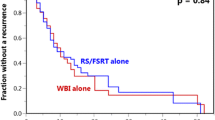Background and Purpose:
For patients with inoperable brain metastases, whole brain radiotherapy (WBRT) has been the standard treatment for decades. Radiosurgery is an effective alternative strategy, but has failed to show a substantial survival benefit so far. The prognostic factors derived from the RTOG recursive partitioning analysis (RPA) provide a framework that allows a nonrandomized comparison of the two modalities.
Patients and Methods:
From 1991 to 1998, 117 patients with one to three previously untreated cerebral metastases underwent single-dose linac radiosurgery (median dose 20 Gy) without adjuvant WBRT. After radiosurgery, 26/117 patients (22%) had salvage WBRT, radiosurgery or neurosurgical resection of recurrent (4/117) and/or new (24/117) metastases. Survival of these patients was compared to a historical group of 138 patients with one to three lesions treated by WBRT (30–36 Gy/3-Gy fractions) from 1978 to 1991; only nine of these patients (7%) had salvage WBRT. All patients were classified into the three RPA prognostic classes based on age, performance score, and presence of extracranial tumor manifestations.
Results:
In RPA class I (Karnofsky performance score ≥ 70, primary tumor controlled, no other metastases, age < 65 years), radiosurgery resulted in a median survival of 25.4 months (n = 23, confidence interval [CI] 5.8–45.0) which was significantly longer than for WBRT (n = 9, 4.7 months, CI 3.8–5.5; p < 0.0001). In RPA class III (Karnofsky performance score < 70), no significant difference in survival between radiosurgery (n = 20, 4.2 months, CI 3.2–5.3) and WBRT (n = 68, 2.5 months, CI 2.2–2.8) was found. In RPA class II (all other patients), radiosurgery produced a small, but significant survival advantage (radiosurgery: n = 74, 5.9 months, CI 3.2–8.5, WBRT: n = 61, 4.1 months, CI 3.4–4.9; p < 0.04).
Conclusion:
Radiosurgery in patients with one to three cerebral metastases results in a substantial survival benefit only in younger patients with a low systemic tumor burden when compared to WBRT alone. It cannot be excluded that this effect is partially caused by the available salvage options after radiosurgery.
Hintergrund und Ziel:
Für Patienten mit inoperablen Hirnmetastasen ist die Ganzhirnbestrahlung (WBRT) seit Jahrzehnten die Standardtherapie. Die Radiochirurgie stellt eine effektive Therapiealternative dar, jedoch wurde bisher kein eindeutiger Überlebensvorteil nachgewiesen. Die Risikogruppen der rekursiven Partitionsanalyse (RPA) der RTOG ermöglichen einen sinnvollen, nicht randomisierten Vergleich von WBRT und Radiochirurgie.
Patienten und Methodik:
Von 1991 bis 1998 erhielten 117 nicht vorbehandelte Patienten mit ein bis drei Hirnmetastasen eine Linac-Radiochirurgie (mediane Dosis 20 Gy) ohne adjuvante WBRT. Zusätzlich wurden 26/117 Patienten (22%) wegen eines lokalen Metastasenrezidivs (4/117) oder neu aufgetretener Hirnmetastasen (24/117) erneut mittels Radiochirurgie, WBRT oder neurochirurgischer Resektion behandelt. Das Überleben dieser Patienten wurde mit einer historischen Gruppe verglichen (n = 138), die von 1978 bis 1991 bei ein bis drei Hirnmetastasen eine alleinige Ganzhirnbestrahlung (30–36 Gy/3-Gy-Fraktionen) erhielt. Hiervon wurden nur neun Patienten (7%) wegen eines Rezidivs erneut mit einer WBRT behandelt. Alle Patienten wurden entsprechend ihrem Alter, dem Allgemeinzustand (Karnofsky-Index) und der Präsenz extrakranieller Tumormanifestationen in die drei RPA-Klassen eingeteilt.
Ergebnisse:
In der RPA-Klasse I (Karnofsky-Index ≥ 70, Primärtumor kontrolliert, keine weiteren Metastasen, Alter < 65 Jahre) führte die Radiochirurgie zu einem medianen Überleben von 25,4 Monaten (n = 23, Konfidenzintervall [CI] 5,8–45,0) und war somit der WBRT signifikant überlegen (n = 9, 4,7 Monate, CI 3,8–5,5; p < 0,0001). In der RPA-Klasse III (Karnofsky-Index < 70) ließ sich kein signifikanter Vorteil der Radiochirurgie (n = 20, 4,2 Monate, CI 3,2–5,3) gegenüber der WBRT (n = 68, 2,5 Monate, CI 2,2–2,8) nachweisen. In der RPA-Risikoklasse II (alle anderen Patienten) führte die Radiochirurgie nur zu einem geringen, aber signifikanten Überlebensvorteil (Radiochirurgie: n = 74, 5,9 Monate, CI 3,2–8,5, WBRT: n = 61, 4,1 Monate, CI 3,4–4,9; p < 0,04).
Schlussfolgerung:
Im Vergleich zur alleinigen WBRT führt die Radiochirurgie bei Patienten mit ein bis drei Hirnmetastasen nur in jüngerem Alter und bei geringer systemischer Tumorausbreitung zu einer Prognoseverbesserung. Möglicherweise spielt hierfür die höhere Verfügbarkeit von Salvage-Therapien eine Rolle.
Similar content being viewed by others
Author information
Authors and Affiliations
Corresponding author
Rights and permissions
About this article
Cite this article
Kocher, M., Maarouf, M., Bendel, M. et al. Linac Radiosurgery Versus Whole Brain Radiotherapy for Brain Metastases. Strahlenther Onkol 180, 263–267 (2004). https://doi.org/10.1007/s00066-004-1180-y
Received:
Accepted:
Issue Date:
DOI: https://doi.org/10.1007/s00066-004-1180-y




